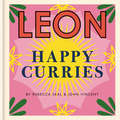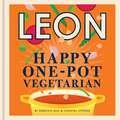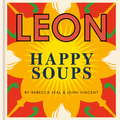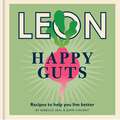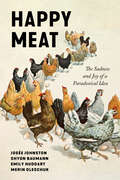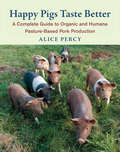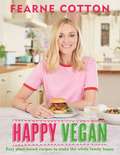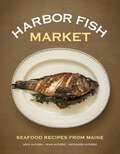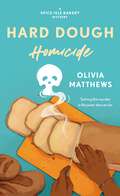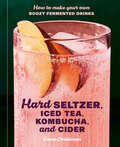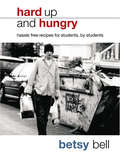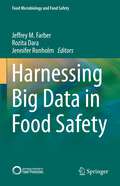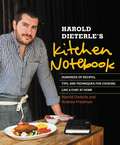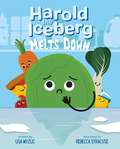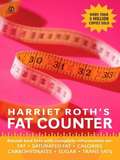- Table View
- List View
Happy Leons: Leon Happy Curries (Happy Leons #1)
by John Vincent Rebecca SealThe latest book in the LEON Happy series - more than 250,000 copies in print.LEON, the home of naturally fast food, have turned their hand to creating a collection of curries - more than 100 new recipes inspired by dishes from Sri Lanka, India, Thailand and Burma, as well as Kenya, Somalia and the Caribbean. Find fiery, speedy, warming or creamy curries, plus everything you might want on the side, from fluffy flatbreads and perfect rice to crunchy relishes, garlicky greens and tangy pickles. If you want fast fixes with easy wins from a supermarket, or something more fancy for when you have a little more time, you will find them all here.Includes Sri Lankan jackfruit and vegetable curry, Kashmiri lamb rogan josh, Skinny salmon and coconut curry and Katsu chicken curry as well as tasty side dishes and tips for speedy curries and ingredient swaps.
Happy Leons: Leon Happy One-pot Vegetarian (Happy Leons #5)
by Rebecca Seal Chantal SymonsLEON are back with a collection of more than 100 fuss-free, full-of-flavour recipes for vegetarian and vegan main course dishes that you can create with only one cooking pot, pan or baking tray.Enjoy simple-to-follow, satisfying recipes that are perfect for any occasion, whether you are looking for a mid-week supper, a quick weekend lunch or something impressive (but easy) for friends or family. From fiery tray bakes to comforting casseroles, LEON Happy One-pot Vegetarian is all about the food and not the washing up. Chapters include Lunchy Brunchy, Fast & Easy, Food for Friends, Light & Simple and Slow & Hearty.
Happy Leons: Leon Happy One-pot Vegetarian (Happy Leons #5)
by Rebecca Seal Chantal SymonsLEON are back with a collection of more than 100 fuss-free, full-of-flavour recipes for vegetarian and vegan main course dishes that you can create with only one cooking pot, pan or baking tray.Enjoy simple-to-follow, satisfying recipes that are perfect for any occasion, whether you are looking for a mid-week supper, a quick weekend lunch or something impressive (but easy) for friends or family. From fiery tray bakes to comforting casseroles, LEON Happy One-pot Vegetarian is all about the food and not the washing up. Chapters include Lunchy Brunchy, Fast & Easy, Food for Friends, Light & Simple and Slow & Hearty.
Happy Leons: Leon Happy Soups
by John Vincent Rebecca SealFollowing the success of Leon Happy Salads - more than 60,000 copies sold - the Leon team is back, this time with delicious warming soups that are a meal in themselves.Leon, the home of naturally fast food, has created a collection of more than 100 all-new, all-smiles soup recipes for Comforting, Naturally Fast, Bright & Fresh, Posh and Sweet Soups, plus those all-important Sides and Crunchy Tops & Swirly Swirls. Whether you're looking for a simple soup to take to work or something more elaborate for supper with friends, this book has the answer, with straightforward yet delicious recipes for all occasions.'Souping - the new juicing' - the Telegraph
Happy Leons: Recipes to help you live better (Happy Leons #4)
by John Vincent Rebecca Seal***LEON was founded on the principle of nourishing the soul with food that nourishes the body - making us happy as a result.In the latest book in the bestselling LEON Happy series, the LEON team have created more than 100 recipes on eating fora happy, healthy gut and a boosted immune system. This is not about eating a restrictive diet or depriving yourself of deliciousfood, but instead incorporating gut-friendly ingredients into your daily diet with recipes loaded with fibre, live microbes, omega-3 and the colours of the rainbow - but less sugar.In addition to recipes, LEON Happy Guts offers the latest advice on improving your gut health, including why we should all use extra virgin olive oil in abundance and how wine and cheese might actually be good for you.
Happy Leons: Recipes to help you live better (Happy Leons #4)
by John Vincent Rebecca SealLEON, the home of healthy fast food, brings you more than 100 simple, colourful, delicious new recipes to recharge your gut, boost your immune system and transform your health. 'So excited to get cooking with Rebecca Seal's new book LEON Happy Guts! Some incredible microbiome-friendly recipes!' Professor Jack Gilbert, PhD, world-renowned microbiome scientist at the University of California San DiegoLEON was founded on the principle of nourishing the soul with food that nourishes the body - making us happy as a result.In the latest book in the bestselling LEON Happy series, the LEON team have created more than 100 recipes on eating for a happy, healthy gut and a boosted immune system. This is not about eating a restrictive diet or depriving yourself of delicious food, but instead incorporating gut-friendly ingredients into your daily diet with recipes loaded with fibre, live microbes, omega-3 and the colours of the rainbow - but less sugar.In addition to recipes, LEON Happy Guts offers the latest advice on improving your gut health, including why we should all use extra virgin olive oil in abundance and how wine and cheese might actually be good for you.
Happy Meat: The Sadness and Joy of a Paradoxical Idea (Culture and Economic Life)
by Josee Johnston Shyon Baumann Emily Huddart Kennedy Merin OleschukNorth Americans love eating meat. Despite the increased awareness of the meat industry's harms–violence against animals, health problems, and associations with environmental degradation–the rate of meat eating hasn't changed significantly in recent years. Instead, what has emerged is an uncomfortable paradox: a need to square one's values with the behaviors that contradict those values. Using a large-scale, multidimensional, and original dataset, Happy Meat explores the thoughts and emotions that underpin our moral decision-making in this meat paradox. Conscientious meat-eaters turn to the notion of "happy meat" to make sense of their behaviors by consuming meat they see as more healthy, ethical, and sustainable. Happy meat might be labeled grass fed, free-range, antibiotic free, naturally raised, or humane. The people who produce and consume it, together, make up the complex landscape of conscientious meat-eating in modern Western societies. The discourse of happy meat ultimately may not be a sufficient response to all the critiques of meat eating, rife as it is with contradictions. However, it offers a powerful case for understanding how moral boundaries and notions of the 'good eater' are constructed through negotiations of values, identity, and status.
Happy People Are Annoying
by Josh PeckA wonderfully candid memoir from one of the most recognizable faces of a generation, actor, writer, Youtuber, and television superstar, Josh Peck. In his warm and inspiring book, Josh reflects on the many stumbles and silver linings of his life and traces a zigzagging path to redemption. Written with such impressive detail and aching honesty, Happy People are Annoying is full of surprising life lessons for anyone seeking to accept their past and make peace with the complicated face in the mirror.Josh Peck rose to near-instant fame when he starred for four seasons as the comedic center of Nickelodeon’s hit show Drake & Josh. However, while he tried to maintain his role as the funniest, happiest kid in every room, Josh struggled alone with the kind of rising anger and plummeting confidence that quietly took over his life.For the first time, Josh reflects on his late teens and early twenties. Raised by a single mother, and coming of age under a spotlight that could be both invigorating and cruel, Josh filled the cratering hole in his self-worth with copious amounts of food, television, drugs, and all of the other trappings of young stardom. Until he realized the only person standing in his way...was himself. Today, with a string of lead roles on hit television shows and movies, and one of the most enviable and dedicated fanbases on the internet, Josh Peck is more than happy, he’s finally, enthusiastically content.Happy People are Annoying is the culmination of years of learning, growing, and finding bright spots in the scary parts of life. Written with the kind of humor, strength of character, and unwavering self-awareness only someone who has mastered their ego can muster, this memoir reminds us of the life-changing freedom on the other side of acceptance.
Happy Pigs Taste Better: A Complete Guide to Organic and Humane Pasture-Based Pork Production
by Alice PercyWhat does it take to raise a happy pig? Armed with experience from running the largest organic hog operation in Maine, author Alice Percy is well equipped to answer this question.Pigs are much closer to their cousin, the wild boar, than other domesticated animals. Ethically managing pigs requires an understanding of their natural mannerisms, including factors such as social grouping, mating, territory, housing, and, of course, their love of wallowing in the mud.In Happy Pigs Taste Better Percy offers a comprehensive look at raising organic, pasture-fed, gourmet meat. She advises readers on pasturing and feeding hogs organically, as well as managing the breeding herd and administering effective natural healthcare. In addition, she provides an overview of marketing and distribution for those looking to turn their hog farming operation into a lucrative business.This book is the first of its kind to offer an in-depth approach to organic, high-welfare commercial production, including information on:– Designing a hog business from the ground up– Housing pigs, including benefits and drawbacks of various housing systems– Evaluating the nutritional content of common organic feedstuffs– Butchering humanely and economically– Recordkeeping, with templates for financial trackingWhether you&’re looking to convert a conventional operation to organic, grow your backyard hog operation into a viable business, or start from scratch, this comprehensive book has got you covered, nose to tail.
Happy Skin Kitchen: Over 100 Plant-Based Recipes to Nourish Your Skin from the Inside Out
by Elisa RossiFrom Elisa Rossi, the creator and recipe developer of Happy Skin Kitchen, more than 100 everyday, skin-enriching, plant-based recipes for better health and a youthful radiant complexion.What is the secret to the clearest, most radiant skin of your life? The answer is right here on our plates. Feed your skin with exactly what it needs to glow and experience your own transformation with over 100 skin-enriching, plant-based recipes, packed with powerful nutrients to nourish your skin from within.Based on Elisa Rossi’s own journey of fighting hormonal cystic acne, and the latest science-based research with the input and expertise of nutritional therapist Sophie Trotman, Happy Skin Kitchen shares recipes with essential building blocks for a dewy complexion, strong nails, and luscious healthy hair. Slow the exterior signs of aging and prevent unsightly breakouts using Elisa’s 15 favorite secret “skingredients,” fantastic for building collagen as well as delivering antioxidant and anti-inflammatory properties.Nourish your skin from the inside out with soulful soups and stews, pastas that pack a flavor punch, fermented foods, bountiful breakfasts, satisfying salads, and sweets and snacks that won’t result in a breakout. The path to flawless, youthful, supple skin starts in your own kitchen, without the need for expensive creams and treatments.
Happy Vegan: Easy plant-based recipes to make the whole family happy
by Fearne CottonAt last! Easy plant-based recipes to make the whole family happy.'Whether you're a fully-fledged and dedicated vegan, someone that eats vegan when cooking at home but veers off when out and about, or completely new to vegan food, I hope you enjoy the process of recreating these recipes and ultimately of eating the finished results' Fearne xSo, what's a Happy Vegan? One that's well fed, well-nourished and satisfied by the delicious and innovative plant-based recipes they're cooking ...With simple recipe hacks and flexible options, delicious classics and fresh ideas, Happy Vegan will inspire you to eat plant-based food full time, part time or any time. It's packed with comforting, easy-to-make dishes that will become your everyday favourites and go-to fridge raiders.Recipes include ideas to start the day right, for lunch on the go, some long and lazy slow cooking, dishy dinners, sharing feasts, party time and irresistible sweetest things. From burgers to brownies, casseroles to cakes, Happy Vegan shows you that vegan food is for everyone ... and you won't even notice there's no meat or dairy. Just happy faces.PRAISE FOR FEARNE COTTON'S COOKBOOKS:'... easy ways to feed everybody and put a smile on their faces while you're at it' Sunday Mirror'Congrats on your brill new book!' Jamie Oliver
Happy Vegan: Easy plant-based recipes to make the whole family happy
by Fearne CottonAt last! Easy plant-based recipes to make the whole family happy.'Whether you're a fully-fledged and dedicated vegan, someone that eats vegan when cooking at home but veers off when out and about, or completely new to vegan food, I hope you enjoy the process of recreating these recipes and ultimately of eating the finished results' Fearne xSo, what's a Happy Vegan? One that's well fed, well-nourished and satisfied by the delicious and innovative plant-based recipes they're cooking ...With simple recipe hacks and flexible options, delicious classics and fresh ideas, Happy Vegan will inspire you to eat plant-based food full time, part time or any time. It's packed with comforting, easy-to-make dishes that will become your everyday favourites and go-to fridge raiders.Recipes include ideas to start the day right, for lunch on the go, some long and lazy slow cooking, dishy dinners, sharing feasts, party time and irresistible sweetest things. From burgers to brownies, casseroles to cakes, Happy Vegan shows you that vegan food is for everyone ... and you won't even notice there's no meat or dairy. Just happy faces.PRAISE FOR FEARNE COTTON'S COOKBOOKS:'... easy ways to feed everybody and put a smile on their faces while you're at it' Sunday Mirror'Congrats on your brill new book!' Jamie Oliver
Happy, Healthy, Strong: The Secret to Staying Fit for Life
by Krissy Cela"This woman will change how you exercise forever"--YOU MagazineFEEL-GOOD FOOD AND FITNESS. UNBELIEVABLE RESULTS.Fitness guru Krissy Cela wants to transform your life with her 360-degree approach to exercise, eating well and mindset, with results that really work.Happy Healthy Strong is a simple and achievable plan that you can do at home, focusing on three key elements for life-long success:- Train Your Brain - to build your mental strength- Fuel Your Life - more than 80 easy, delicious recipes to keep your body strong and satisfied- Move Move Move - over 45 at-home exercises, complete with build-your-own workout guides for every levelLooking after your body and mind is the most important thing you can do for happiness and wellbeing; it means so much more than a number on the scales. Through Krissy's tried-and-tested advice, you will feel great and get results you've never thought possible, with a program you can stick to for life.With Happy Healthy Strong, you can say goodbye to yo-yo dieting, feel great, and live a life that truly empowers you.
HappyBaby
by Robert W. SearsA healthy baby is a HAPPYBABY! From the most respected names in parenting come this definitive book on child rearing the all-natural way. HappyBaby combines decades of medical expertise from Dr. Robert W. Sears, renowned doctor in the Sears family of pediatricians, with the nutritional know-how of Amy Marlow, registered dietitian for the popular HAPPYBABY line of organic baby food. Look no further than between the pages of this jam-packed guide to find answers to critically important questions in the life of your baby, such as: What should I eat when nursing my baby to ensure the most nutritional feedings? What simple tips can help me manage the inevitable stress that comes with a new baby in the house? I'm worried about toxins in my baby's nursery. How can I green the new room? When do I introduce my child to solid foods, and how can I do it in a safe and fun way? How can I develop healthy eating habits in my children? This groundbreaking book offers a proactive, harmonious approach to parenting that's easier, greener, and just plain better for your precious infant or toddler.
HappyBaby
by Robert W. SearsA healthy baby is a HAPPYBABY!From the most respected names in parenting come this definitive book on child rearing the all-natural way. HappyBaby combines decades of medical expertise from Dr. Robert W. Sears, renowned doctor in the Sears family of pediatricians, with the nutritional know-how of Amy Marlow, registered dietitian for the popular HAPPYBABY line of organic baby food. Look no further than between the pages of this jam-packed guide to find answers to critically important questions in the life of your baby, such as:What should I eat when nursing my baby to ensure the most nutritional feedings?What simple tips can help me manage the inevitable stress that comes with a new baby in the house?I'm worried about toxins in my baby's nursery. How can I green the new room?When do I introduce my child to solid foods, and how can I do it in a safe and fun way?How can I develop healthy eating habits in my children?This groundbreaking book offers a proactive, harmonious approach to parenting that's easier, greener, and just plain better for your precious infant or toddler.
Harbor Fish Market: Seafood Recipes from Maine
by Nick AlfieroFor over 30 years, Harbor Fish Market in Portland, Maine, has been providing the highest quality seafood available. Through its retail store and food service division, it services retail customers, fine restaurants, and institutions. It also reaches thousands of customers through its retail airfreight department, and national wholesale sales department. In addition to its physical reach, Harbor Fish Market has become an iconic destination for tourists and locals alike: it is the authority on Maine seafood. With beautiful displays, knowledgeable family-run staff, and the best seafood around, Harbor Fish is synonomous with Maine&’s iconic industry. Finally, the family behind the successful business offers up decades worth of recipes and expertise so that you can cook up a delicious dish. From appetizers to soups to entrees, this collection of family-tested recipes is the must-have Maine seafood cookbook.
Hard Dough Homicide: A Spice Isle Bakery Mystery (Spice Isle Bakery Mysteries #2)
by Olivia MatthewsSomeone in Brooklyn’s Little Caribbean neighborhood has an appetite for murder in Olivia Matthews' Hard Dough Homicide. Spice Isle Bakery owner Lyndsay Murray is always looking for new ways to grow her family’s business. But she already regrets agreeing to host the retirement dinner for local high school principal Emily Smith. The tyrant used to be her mother's boss and they did not get along. Six guests arrive for the celebration, but only five survive. Emily starts convulsing—right after eating the curry chicken—and dies soon after. It’s not long before the police are knocking on Spice Isle’s door, bringing the Murray family back into the heart of another murder investigation—driving away customers in the process. Lyndsay can't help but wonder if this is the end of the bakery, even though it's just begun. She must put aside her reservations about investigating another crime, because the Murrays refuse to go down without a fight.
Hard Seltzer, Iced Tea, Kombucha, and Cider: How to Make Your Own Boozy Fermented Drinks
by Emma ChristensenAn easy and accessible guide to making hard fizzy drinks—from seltzer and iced tea to kombucha and cider—at home from the author of True Brews.&“Emma Christensen&’s latest fermented tour de force is equal parts educational and entertaining, providing a recipe-driven road map to the rapidly expanding drinking world.&”—Joshua M. Bernstein, author of The Complete Beer CourseImagine coming home from the farmers market and making a delicious batch of all-natural Strawberry Hard Kombucha. Or treating yourself to a Blackberry Hard Seltzer after picking a batch of blackberries during an afternoon walk. Or whipping up a few gallons of Mai Tai Hard Iced Tea to share at backyard barbecues this summer. And the best part? These homemade drinks are easy and budget-friendly, and expert homebrewer Emma Christensen has got you covered!Whether you want to recreate your favorite canned drink or flex your own creative muscles with all-natural ingredients, Emma will be with you every step of the way, ensuring every batch is a success. Hard Seltzer, Iced Tea, Kombucha, and Cider is chock full of helpful techniques and tips to make your own fizzy delights in no time. Choose from over 45 recipes organized from basic to adventurous, popular to off-beat, and low-ABV to higher ABV. Recipes include Yuzu-Plum Hard Seltzer, Mint Julep Hard Iced Tea, Blueberry-Pomegranate Hard Kombucha, Mulled Cranberry Hard Cider, and many more.Emma will soon have you strolling the grocery store and wondering &“Will it fizz?&” with everything you see!
Hard Up And Hungry: Hassle free recipes for students, by students
by Betsy BellThis student cookbook stands out from all the others on the market. It doesn't feature baked beans, and it's packed with truly mouthwatering, easy, nutritious recipes. Betsy Bell wrote this book for her children and their friends when they were heading to university. She realised that they all knew little (or nothing) about culinary survival, but that their sophisticated tastes went beyond the standard macaroni cheese and beans on toast recipes that feature in other student cookbooks. So Hard Up and Hungry includes recipes that students will want to make; that are tempting enough to keep them away from the nearest pizza outlet or chip shop. It includes Spaghetti with Fennel and Smoked Bacon, Spinach Frittata, Cod with Olives and Sweet Peppers, Southwestern Burgers, Italian Rice and Beans and sweet treats (including American pancakes and Vodka Jelly). Betsy doesn't forget the basics either: the ultimate Bacon Butty, Boiled Eggs and Baked Potatoes all feature too. The book is also packed with advice on how to store and shop for food inexpensively (including alternatives to supermarkets, and the pros and cons of online shopping). Illustrated throughout with hip black and white photographs and wiro bound, this is the ultimate cookbook for students and anyone who wants to cook fantastic food on a budget.
Harmful Invaders: Eat Them to Beat Them / Dining on Invaders: A Recipe for Trouble (Fountas & Pinnell Classroom, Guided Reading)
by Corey Flannigan Tom CostaNIMAC-sourced textbook
Harnessing Big Data in Food Safety (Food Microbiology and Food Safety)
by Jeffrey M. Farber Rozita Dara Jennifer RonholmBig Data technologies have the potential to revolutionize the agriculture sector, in particular food safety and quality practices. This book is designed to provide a foundational understanding of various applications of Big Data in Food Safety. Big Data requires the use of sophisticated approaches for cleaning, processing and extracting useful information to improve decision-making. The contributed volume reviews some of these approaches and algorithms in the context of real-world food safety studies. Food safety and quality related data are being generated in large volumes and from a variety of sources such as farms, processors, retailers, government organizations, and other industries. The editors have included examples of how big data can be used in the fields of bacteriology, virology and mycology to improve food safety. Additional chapters detail how the big data sources are aggregated and used in food safety and quality areas such as food spoilage and quality deterioration along the supply chain, food supply chain traceability, as well as policy and regulations. The volume also contains solutions to address standardization, data interoperability, and other data governance and data related technical challenges. Furthermore, this volume discusses how the application of machine-learning has successfully improved the speed and/or accuracy of many processes in the food supply chain, and also discusses some of the inherent challenges. Included in this volume as well is a practical example of the digital transformation that happened in Dubai, with a particular emphasis on how data is enabling better decision-making in food safety. To complete this volume, researchers discuss how although big data is and will continue to be a major disruptor in the area of food safety, it also raises some important questions with regards to issues such as security/privacy, data control and data governance, all of which must be carefully considered by governments and law makers.
Harnessing Nanoencapsulation: Valorization of Bioactive Compounds for Health and Beyond (Food Bioactive Ingredients)
by Sajad Ahmad Wani Haroon Rashid NaikNanotechnology has emerged as a groundbreaking field with immense potential in various industries, particularly in biomedicine and food science. One of its most promising applications is the encapsulation of bioactive compounds at the nanoscale. This innovative technique offers numerous advantages, including enhanced stability, controlled release, and targeted delivery, thereby revolutionizing the utilization of bioactive compounds for health promotion, disease prevention, and beyond. This book explores the valorization of nanoencapsulated bioactive compounds, delving into the science, technology, applications and implications of this cutting-edge approach. Harnessing Nanoencapsulation: Valorization of Bioactive Compounds for Health and Beyond explores cutting-edge nanoencapsulation techniques for enhancing the delivery of bioactive compounds, ensuring their stability and bioavailability for improved health benefits. The book discusses the customization of nanoencapsulation formulations to optimize the protection, release, and targeting of specific bioactive compounds, catering to diverse applications in healthcare and beyond. The text examines how nanoencapsulation can amplify the bioactivity of encapsulated compounds, enabling controlled release kinetics and sustained effects for enhanced therapeutic outcomes and functional food applications. The chapters highlight the potential synergies achieved by combining nanoencapsulation with various bioactive compounds, unlocking new possibilities for multifunctional formulations with enhanced efficacy and versatility. The diverse applications of nanoencapsulation are explored, plus cutting-edge nanoencapsulation techniques for enhancing the delivery of bioactive compounds, ensuring their stability and bioavailability for improved health benefits.
Harold Dieterle's Kitchen Notebook: Recipes For Modern American Dishes
by Andrew Friedman Harold DieterleMany chefs keep notebooks in their kitchens, filled with recipe ideas, new ways to use an ingredient, and records of what did or did not work. But how often do ordinary food lovers get to peek inside? Now Harold Dieterle-- chef-owner of New York City's popular restaurants Perilla, Kin Shop, and The Marrow, and Season 1 champion of the hit TV show Top Chef-- pulls back the curtain to give every home cooks a look inside his kitchen. Incorporating his eclectic mix of New American, Italian, Thai, and German influences, this cookbook offers restaurant-caliber dishes that can be easily prepared at home. While each dish comprises several elements, one standout ingredient or component will be identified in each (starred here) and accompanied by Harold's notebook entry sharing why that ingredient is so special and offering a number of additional ways to use it. Dishes include: Fresh Ricotta Cheese* with Acorn Squash Tempura, Truffle Honey, and Toasted Bread; Wild Chive* Tagliatelli with Shrimp, Cuttlefish, Shallots, and Sea Urchin Sauce; Roasted Whole Chicken with Spaetzle*, Chestnuts, and Persimmons; Grilled Venison Sirloin with Potato-Leek Gratin, Swiss Chard, and Huckleberry* Sauce; Warm Flourless Chocolate and Peanut Butter Soufflé Cake with Coffee Crème Anglaise*; and many more!
Harold the Iceberg Melts Down (Harold the Iceberg #1)
by Lisa WyzlicAccompanied by Rebecca Syracuse’s bold, whimsical artwork, Lisa Wyzlic’s debut picture book Harold the Iceberg Melts Down is all about the importance of friendship and self-care, perfect for any young reader worried about their planet’s future.Harold is an iceberg... lettuce. (But he doesn't realize the "lettuce" part because part of his sticker has ripped off.) So one day when he sees a documentary about how the icebergs are melting, Harold starts to worry, thinking that he's melting too.As his anxiety grows and grows, and he tries to find a way to stop melting, his fellow food friends try to help him cool down in a different way.
Harriet Roth's Fat Counter (Revised Edition)
by Harriet RothA new revised edition of the bestselling Fat Counternow with updated material on trans fats, carbs, and sugar! Americans have more food choices and more to watch out for than ever. Research suggests that trans-fat, carbohydrates, and sugar can be major diet-busters. It's key to cut down on dietary fat and saturated fat in particular, and watch food labels. In this third revised edition of her bestselling guide, Harriet Roth offers the additional feature of trans fat, sugar and carb counts-and updates her listings to include the newest supermarket products, fast food, and restaurant foods.
